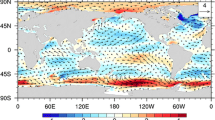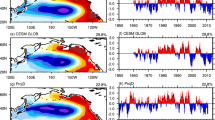Abstract
The Miami Isopycnal Coordinate Ocean Model (MICOM) is adopted to simulate the interdecadal variability in the Pacific Ocean with most emphasis on regime shifts in the North Pacific. The computational domain covers 60°N to 40°S with an enclosed boundary condition for momentum flux, whereas there are thermohaline fluxes across the southern end as a restoring term. In addition, sea surface salinity of the model relaxes to the climatological season cycle, which results in climatological fresh water fluxes. Surface forcing functions from January 1945 through December 1993 are derived from the Comprehensive Ocean and Atmospheric Data Set (COADS). Such a numerical experiment reproduces the observed evolution of the interdecadal variability in the heat content over the upper 400-m layer by a two-year lag. Subduction that occurs at the ventilated thermocline in the central North Pacific is also been simulated and the subducted signals propagate from 35°N to 25°N, taking about 8 to 10 years, in agreement with the eXpendable Bathy Thermograph observation over recent decades. Interdecadal signals take a southwestward and downward path rather than westward propagation, meaning they are less associated with the baroclinic planetary waves. During travel, the signals appear to conserve potential vorticity. Therefore, the ventilated thermocline and related subduction are probably the fundamental physics for interdecadal variability in the mid-latitude subtropics of the North Pacific.
Similar content being viewed by others
References
Auad, G., Miller, A. J. White, W. B., 1998: Simulation of heat storages and associated heat budgets in the Pacific Ocean, 2, Interdecadal timescale.J. Geophys. Res.,103, 27621–27635.
Barnett, T. P., 1983, Interaction of the monsoon and Pacific trade wind system at interannual time scales. Part I: The equatorial zone.Mon. Wea. Rev.,111, 756–773.
Bleck, R., C. Rooth, D. Hu, and L. T. Smith, 1992: Salinity-driven transients in a wind- and thermohaline-forced isopycnic coordinate model of the North Atlantic.J. Phys. Oceanogr.,22, 1486–1505.
Deser, C., M. A. Alexander, and M. S. Timlin, 1996: Upper-ocean thermal variations in the North Pacific during 1970–1991.J. Climate,9, 1840–1855.
Gu, D. F., and S. G. H. Philander, 1997: Interdecadal climate fluctuations that depend on exchanges between the tropics and extratropics.Science,275, 805–807.
Huang, R. X., and J. Pedlosky, 1999: Climate variability inferred from a layered model of the ventilated thermocline.J. Phys. Oceanogr.,29, 779–790.
Kraus, E. B., and J. S. Turner, 1967: A one-dimensional model of the seasonal thermocline, II The general theory and its consequences.Tellus,19, 98–105.
Latif, M., and T. P. Barnett, 1994: Causes of decadal climate variability over the North Pacific and North America.Science,266, 634–637.
Liu, Z., and S.-I. Shin, 1999: On thermocline ventilation of active and passive tracers.Geophys. Res. Lett.,26, 357–360.
Lysne, J., P. Chang, and B. Giese, 1997: Impact of the extratropical Pacific on equatorial variability,Geophys. Res. Lett.,24, 2589–2592.
Mantua, N. J., S. R. Hare, Y. Zhang, J. M. Wallace, and R. C. Francis, 1997: A Pacific interdecadal climate oscillation with impacts on salmon production.Bull. Amer. Meteor. Soc.,78, 1069–1079.
Minobe, S., 1999: Resonance in bidecadal and pentadecadal climate oscillations over the North Pacific: role in climatic regime shifts.Geophys. Res. Lett.,26, 855–858.
Nonaka, M., and S.-P. Xie, 2000: Propagation of North Pacific interdecadal subsurface temperature anomalies in an ocean GCM.Geophys. Res. Lett.,27, 3747–3750.
Schneider, N., A. J. Miller, M. A. Alexander, and C. Deser, 1999: Subduction of decadal North Pacific temperature anomalies: Observations and dynamics.J. Phys. Oceanogr.,29, 1056–1070.
Talley, L. D., 1985: Ventilation of the subtropical North Pacific.J. Phys. Oceanogr.,15, 633–649.
Tourre, Y. M., Y. Kushnir, and W. B. White, 1999: Evolution of interdecadal variability in sea level pressure, sea surface temperature and upper ocean temperature over the Pacific Ocean.J. Phys. Oceanogr.,29, 1528–1541.
Wang Dongxiao, and Zhengyu Liu, 2000: The pathway of the interdecadal variability in the Pacific Ocean.Chinese Science Bulletin,45(17), 1555–1561.
Wang Dongxiao, Wang Jia, Lixin Wu, and Zhengyu Liu, 2003: Relative importance of wind and buoyancy forcing for interdecadal regime shift in the Pacific Ocean.Science in China, D,46(5), 417–427.
White, W. B., 1995: Design of a global observing system for gyre-scale upper ocean temperature variability.Progress in Oceanography,36, 169–217.
White, W. B., and D. R. Cayan, 1998: Quasi-periodicity and global symmetries in interdecadal upper ocean temperature variability.J. Geophys. Res.,103, 21335–21354.
Woodruff, S. D., R. J. Slutz, R. L. Jenne, and P. M. Steurer, 1987: A comprehensive ocean-atmospheric data set.Bull. Amer. Meteor. Soc.,68, 1239–1250.
Zhang, R.-H., and S. Levitus, 1997: Structure and cycle of decadal variability of upper ocean temperature in the North Pacific.J. Climate,10, 710–727.
Zhang, R.-H., L. M. Rothstein, and A. J. Busalacchi, 1998: Origin of upper-ocean warming and El Niño changes on decadal scales in the tropical Pacific Ocean.Nature,391, 879–883.
Zhang, R.-H., and Z. Liu, 1999: Decadal thermocline variability in the North Pacific Ocean: Two pathways around the subtropical gyre.J. Climate,12(11), 3273–3296.
Author information
Authors and Affiliations
Corresponding author
Rights and permissions
About this article
Cite this article
Dongxiao, W., Jia, W., Wu, L. et al. Regime shifts in the North Pacific simulated by a COADS-driven Isopycnal model. Adv. Atmos. Sci. 20, 743–754 (2003). https://doi.org/10.1007/BF02915399
Received:
Revised:
Issue Date:
DOI: https://doi.org/10.1007/BF02915399




